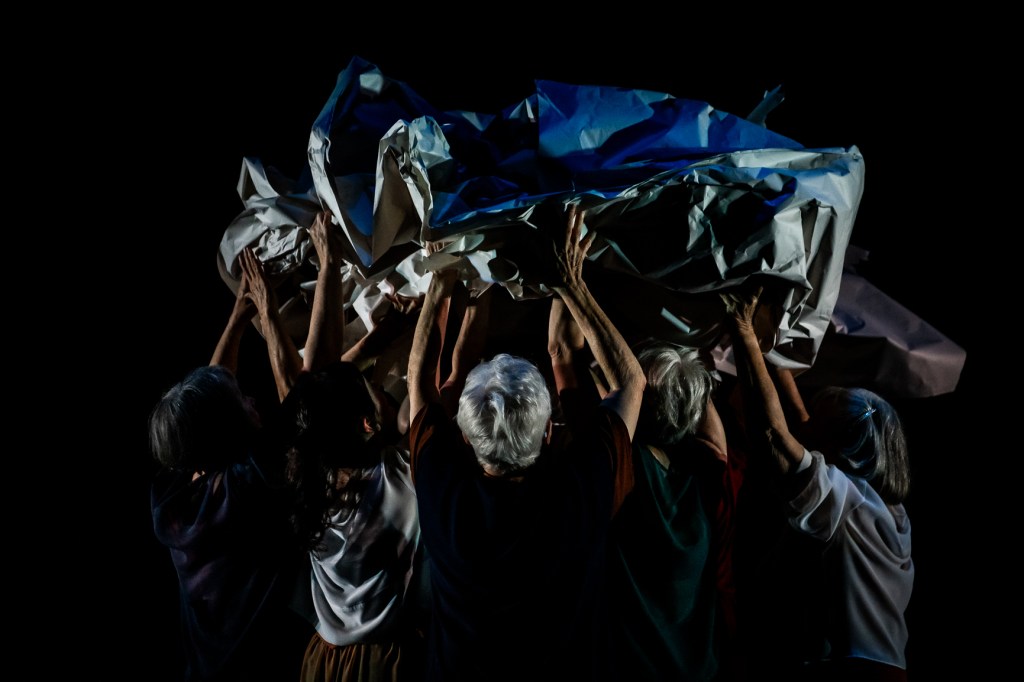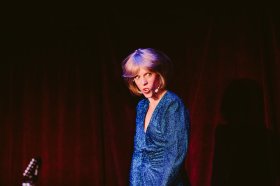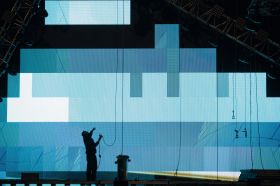To Carry/To Hold is a work gently moulded by the long and strong relationships between nine members of the performing ensemble of MADE (Mature Artists Dance Experience) and visiting choreographer, Liesel Zink. This mature performance ensemble last worked with Zink in 2016 on The Stance. That work made a huge impression, identifying a commitment to deep collaborative engagement for both choreographer and dancers.
To Carry/To Hold is, at its core, an exploration of those two actions, but its meaning is in the personal interpretations, which have been formed in the empowering process Zink brings to the group.
As each dancer stepped into the space, the individuality expressed in their bodies was matched by the gentle care they showed for each other. They appeared comfortable in their own skin, in each other’s company and with the audience.
Towards us, they addressed their generous smiles, their stillness and their attention. We were invited into their world, their experiences shared through speech and gesture while standing along a long roll of white paper. Penny Carey-Wells proudly presented a hand, which has been used to draw since its owner was five; in counterpoint, Annie Greenhill referenced a badly broken wrist, and an arm, which stroked across a past leg injury. Each contribution was very personal – a glimpse of the history of the body they carry.
Together they extended their hands and reached their arms as if to gather and present past experiences through strong, sensual fingertips. As if their memories were written on the paper they stand on, they rolled, carried and repositioned their thoughts. Other layers of paper were laid down and overlapped. Some of the dancers’ arms and prone bodies created creases and folds, changing the course of the clean lines of white paper. These intersections altered the direct course of each paper sheet. Predictable paths became asymmetric zigzags. Their actions have made a permanent impact on the surface and shape of an otherwise pristine material.
Now focusing on their own movement phrases, Shirley Gibson, Jill Clennett and Carey-Wells’ gentle trio was contrasted by the rest of the cast carrying the burden of bundles of paper on their backs. The sound of unwrapping and tearing paper dominated the stage. Gibson’s solo expressed strength. Lucinda Sharp’s solo spoke of a past rich in more lyrically codified movement.
The paper took on a character of its own – sometimes carried as flat sheet, torn and swept away, sometimes torn into small pieces and held tenderly. The paper seemed to breathe in the floor space of the Studio Theatre.
As each member of the ensemble elaborated on their initial movement statements, the ensemble echoed motifs, travelling them in new combinations. Christine Bell, Sharp and Kate Ireland continued the movement exploration in a gentle trio, holding each other’s weight with care and soft contemplation. Their proximity was exaggerated, and they become wrapped up in a cocoon-like spiral. Layers of paper were added as others joined. Sheets were held, scrunched and tucked in and around bodies. Arms reached up, holding the paper walls firm against the resistance of moving air. The structure was both supported and very fragile.
Unfurling like layers of skin, the shape spread, rose, gathered and was carried above heads, as the group shuffled sideways like a paper cloud. With ominous percussive sounds the image was broken. Dancers threw paper with furious energy. Gathering again, the small pieces were brought back together and lifted as a mass of soft swirls. Aśka Smietanska was the centre of attention with the action of others drawn towards her. Strong motifs rippled through the group sequences
Read: Concert Review: Star Wars: Return of the Jedi in Concert, Hamer Hall
Individuals continued to share their movement “stories”. Christine Keele was joined by others stepping side to side and echoing her movement. The audience was focused, strongly connected to the performers. It was as though the patterns of their lives were being revealed, shared, gently woven together, then let go.
To Carry/To Hold was a beautifully poignant dance work made with deep care and authenticity.
To Carry/To Hold
Theatre Royal Hobart
Choreographer: Liesel Zink
Lighting Design: Jason James
Costume and Scenic Design: Roz Wren
Stage Manager: Finn Carter
Rehearsal Director: Angela Barnard
Performers: Christine Bell, Penny Carey-Wells, Jill Clennett, Shirley Gibson,
Annie Greenhill, Kate Ireland, Christine Keele, Lucinda Sharp, Aśka Smietanska
Marketing and PR: M.A.P. Consulting, Maria Pate
To Carry/To Hold was performed at Theatre Royal Hobart from 11-12 April and The Burnie Arts Centre from 17-18 April.





